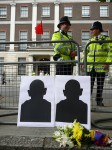A wave of protests in Tibet began in Lhasa on 10 March 2008. In the remainder of that year, more than 150 separate protests were documented across the Tibetan Plateau (the Tibet Autonomous Region and other parts of Tibet in the Chinese provinces of Sichuan, Yunnan, Gansu and Qinghai; for a pdf listing of known protests and their locations, click here*). The overwhelming majority of the protests were non-violent in nature. The Chinese leadership imposed a brutal crackdown in all Tibetan areas to suppress the protests, leading to arrest of thousands of Tibetans and the deaths of over 100 Tibetans. Protests have continued on a regular basis, albeit less frequently, ever since March 2008. See the Stand Up for Tibet website which documents the self-immolation crisis and associated mass protests.
Photo: Silhouettes represent the unknown dead, London 2008. (Tibet Society UK)
 The International Tibet Network co-ordinated the Tibet movement’s response to the crackdown on the protest. To address the crisis, member organisations made the demands below:
The International Tibet Network co-ordinated the Tibet movement’s response to the crackdown on the protest. To address the crisis, member organisations made the demands below:
i.) China must halt its crackdown, withdraw military and security forces, release those detained and allow peaceful protest. China must halt house-to-house searches; and authorities must refrain from any further arrests of Tibetan protesters. We call on our Governments to support these demands.
ii.) Governments must support the Dalai Lama’s call for a UN team of investigators to go to Tibet as soon as possible.
iii.) China must allow foreign journalists back into all Tibetan areas (TAR and Tibetan areas of Gansu, Qinghai and Sichuan) immediately.
* list of protest locations from the report “Tibet At a Turning Point” by the International Campaign for Tibet.
Actions the International Tibet Network coordinated:
Media Response
- We provided Members with news and urgent developments.
- We provided a range of sample press releases and detailed talking points for media work.
- We provided an on-going analysis of trends in media reporting with advice about how to respond to any biased or inaccurate reporting.
- We coordinated a group of experienced Tibet campaigners to write rebuttals to biased or inaccurate reporting.
Advocacy and Public Awareness-Raising
- We called on governments to issue public statements of concern about the situation.
- We wrote to then United Nations High Commissioner for Human Rights, Louise Arbour, on behalf of the network, calling for a public statement and asking her to send investigators to Tibet (she requested permission to visit Tibet, which China refused). We prepared sample letters to governments and UN missions asking for support for investigators to go to Tibet.
- We provided sample letters for Tibet Groups to use to call for politicians and celebrities to stay away from the Opening Ceremony of the Beijing Olympics.
- We wrote on behalf of the movement to the government of Nepal, objecting to its handling of protests by Tibetans in Kathmandu.
- We encouraged groups to stage peaceful demonstrations in solidarity with the Tibetan people and appealing for a calm, non-violent approach.
- We coordinated Global Days of Action. For example on 31 March 2008 over 85 events took place in 30 countries. We supplied talking points for media work, image resources, flyers, sample letters and press releases for these Days of Action.
- We worked closely with online activism organization Avaaz on a global petition of support for dialogue between the Dalai Lama and Hu Jintao. This petition gathered over 1 million 400,000 signatures by the end of March 2008.
Assistance for Tibetans in Tibet:
- We created email action alerts targeting the Beijing Organising Committee of the Olympic Games and China’s Ministry of Foreign Affairs, calling for the immediate re-admission of journalists to Tibet.
- We wrote to Jacques Rogge, President of the International Olympic Committee (IOC), on behalf of the Tibet movement, and prepared sample letters and an Action Alert targeting IOC Executive Board members, calling on them to prevent the Olympic torch being taken through Tibet, in order to prevent further conflict. Our request for a meeting with President Rogge was declined.
- We prepared sample petitions, letters, email action alerts and talking points for members to lobby National Olympic Committees, asking them to use their influence to compel the IOC to withdraw the Beijing Olympic Torch from Tibet. We also wrote to the Association of National Olympic Associations on behalf of the movement.
- We wrote to Olympic sponsors on behalf of the movement, asking them to use their influence to compel the IOC to withdraw the Beijing Olympic Torch from Tibet, and engaged in press work to highlight the potential influence that sponsors possessed.
Information and Resources
- We compiled dossiers of information for use by Tibet Groups. These included government responses to uprisings in Tibet; reactions of athletes; world leaders’ positions on staying away from the Olympics Opening ceremony; a compendium of online photo resources from events in Tibet; lists of Tibetan Autonomous Prefectures and maps showing the location of protests and a comprehensive chronology of events compiled from Tibetan sources.
- We provided Tibetan Freedom Torch materials, including a poster, suggestions of activities groups could organise, flyer, and declaration about the global torch relay.
- We provided advice and small grants to organisations hosting the Tibetan Freedom Torch, and in cities where the Olympic Torch visited.

